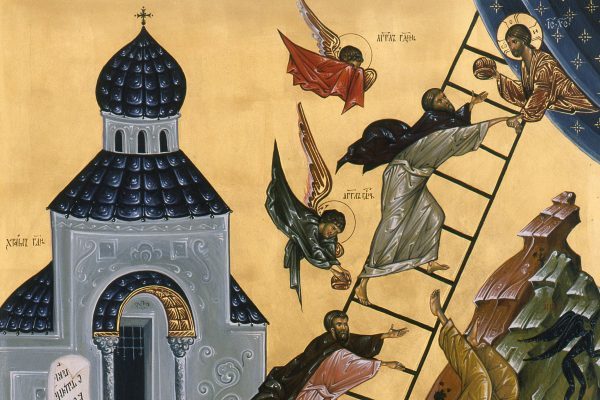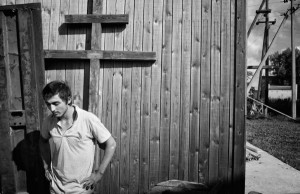How many of us have used a ladder lately? If we are too old or too young, hopefully we have not used a ladder lately! A short stepladder has big steps that one can stand on but it doesn’t go very high. A tall ladder has small steps. An extension ladder reaches much higher but has even smaller steps. Have you ever tried to stand for a while on one of the steps of a tall ladder? What happens? Pretty soon our feet begin to hurt because the step does not fully support the platform of our foot. The longer we stay on one rung, the more our feet hurt and we have to move up or down the ladder.
It is the same way with the Ladder of Divine Ascent that St. John Climacus, whom we commemorate today, the Fourth Sunday of Great and Holy Lent, writes about. The word ‘climacus’ means ‘ladder.’ But what is St. John’s Ladder of Divine Ascent? This ladder has thirty steps. The first three are about detaching from worldly things. The next four have to do with the fundamental virtues. The next sixteen represent the struggle against the passions and sins to be overcome. The next three are the higher virtues in the active life (praxis) and the final four steps represent union with God in the contemplative life (theoria).
So for example, the eighth step in the ladder is about anger. We cannot ascend to that step, master our anger, and then stop there. Nor can we stop on any other step but it’s not because our feet will begin to hurt standing on any one step for a long time. It’s because we will become susceptible to vainglory and pride (Steps 22 & 23) standing long enough to exalt in our supposed achievement of ascent. This is because the Ladder of Divine Ascent is not the goal. Neither is any of its rungs or steps. Christ is the goal. This spiritual ladder is a tool, not the goal.
Professor Panayiotes Chrestou says,
“St. Gregory of Nyssa had earlier indicated that he recognized only one limitation in perfection, that it has not limit. When we climb the ladder of spiritual progress, we will never be able to stop ascending; for there is always a step above the step we occupy and there is not summit. Man continuously becomes more spiritual and his spiritual food continuously increases, without his growth ever ending.”
Fr. Anthony Coniaris, in his book, Sacred Symbols that Speak (vol.1, pp.66-75), says the Ladder itself is a gift from Jesus Christ. He Himself descended the ladder to us in His Incarnation and once again climbed it by His death on the Cross, Resurrection and Ascension into Heaven. Fr. Anthony gives the following example:
“if a poor young man is given a scholarship by a rich benefactor, the lad is given something he could never achieve on his own; a very great gift. But the young man has to be prepared to work, study and toil hard as a student if he is to realize the full benefit of what he has been given. This is then why it is necessary for us to climb the ladder that God has given us in Christ. God gives us the ladder as a gift (a scholarship).”
But for any student, the scholarship is not the goal. It is a means to an education and ultimately a degree and finally a vocation. The ladder is our scholarship but the life in the Church is our education, salvation is our degree and union with Christ (theosis) is our ultimate vocation.
What else can we say about ladders? Have we ever tried to climb a ladder with just our feet? Probably not, because climbing without using our hands to hold on we will likely lose our balance and fall. How about climbing using only our hands? Certainly not because few of us can hold our own weight with just our hands and arms much less actually pull ourselves higher and higher. Soon, our hands weaken and we lose our grip. The best way to climb a ladder is to have at least one hand and one foot on the ladder at all times. With those secure, the other hand and foot can reach for the next rung. But notice how one hand is reaching for a higher rung, while the other hand is firmly gripping a rung below. And the same is true with our feet but our feet are at least two or three rungs below our hands. The same is true on the Ladder of Divine Ascent. At any one time we probably have our hands and feet on three to four different rungs. So, for example, we will simultaneously be working on obedience, repentance, the remembrance of death and joyful sorrow—steps 4,5,6,7 on the Ladder.
So it goes without saying that we should not, we cannot try to leap from one rung to another, skipping steps in between. This is very dangerous and certainly leads to a deadly fall. Spirituality, according to St. John Climacus, is a not mere perfectionism but a never-ending process of climbing and growth leading to new levels of knowledge of God and holiness. He warns,
“You will be rejected if you have the effrontery/arrogance to leap to the top of the ladder of love.” But, if done with humility, the Ladder has a mystical quality that prevents us from seeing to far up the ladder. Here is how one writer explained it, “God’s dealings with us are on an ascending scale. If we see clearly the lowest rung in the heavenly ladder, the veil of mist will depart and we shall see the next above it, and then the next and, in due order, the next; and so the steps that slope away through darkness up to God will always be beckoning to greater and yet greater things.”
To further demonstrate this dynamic, Fr. Coniaris shares a story of a religious man who dreamed he was building a ladder to heaven. When he did a good deed, the ladder went up one more step. When he gave a dollar to charity, he added another step. When he joined the church, the ladder when up ten steps. Higher and higher went the ladder until it reached beyond the clouds out of sight. As the end of his life neared, the man thought that surely the ladder would extend clear up into heaven by then. So, confidently stepping off the top of the ladder, thinking it was heaven, he found nothing there and went tumbling down head over heals to his ruin. Awakening from his dream, he remembered the words of Jesus, “He that…climbs up some other way, the same is a thief and robber (John 10:1). The ladder is the gift of God’s grace. It can never be built by our virtues and good deeds.
As we conclude today, let us remember that St. John’s Ladder of Divine Ascent is not something out there. St. Isaac the Syrian wrote:
“Enter eagerly into the treasure house (the heart) that lies within you, and so you will see the treasure house of heaven. For the two are the same, and there is but on single entry to them both. The ladder that leads to the Kingdom is hidden within you, and is found in your soul. Dive into yourself, and in your soul you will discover the rungs by which you are to ascend.”
St. Gregory of Nyssa writes,
“Having once put your foot on the ladder which God is leaning against, go on climbing…every rung leads up to the beyond…Finding God means looking for Him tirelessly…To see God means never to cease to desire Him.”
God first let this ladder down into your soul when you were baptized. It is still there. God will never to remove it. So, dive into your soul and start climbing it one step at a time, ascending as you defeat the passions on each rung: including slander (10), talkativeness (11), gluttony (14), lust (15), seeking the higher virtues of simplicity (24), humility (25), discernment (26) and so reaching to stillness (27), prayer (28), dispassion (29) and love (30), and finally to Christ Himself, our Lord, God and Savior. Amen!

















